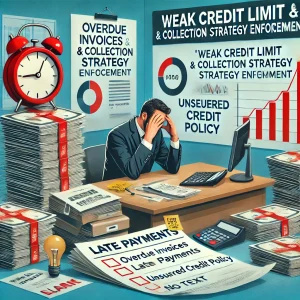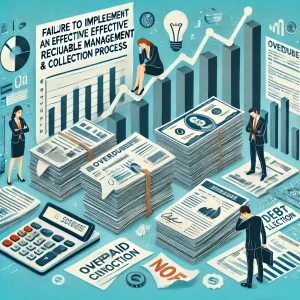Table of Contents
- 1 Credit Policy Best Practices: Why 90% of Business Credit Policies Fail & How to Fix Yours
- 1.1 Common Reasons Credit Policies Fail & Best Practices to Fix Them
- 1.1.1 🚨 1.1 Lack of Clear Objectives & Misalignment with Business Goals
- 1.1.2 🚨 1.2 Poor Credit Risk Assessment & Over-Reliance on Personal Judgment
- 1.1.3 🚨 1.3 Weak Credit Limit & Collection Strategy Enforcement
- 1.1.4 🚨 1.4 Inadequate Training & Poor Communication of Credit Policies
- 1.1.5 🚨 1.5 Failure to Implement an Effective Receivable Management & Collection Process
- 1.1.6 🚨 1.6 Not Segmenting Customers in Credit Decisions
- 1.2 How to Improve Your Credit & Apply Credit Policy Best Practices for Business Success
- 1.2.1 🏆 Step 1: Set Clear Credit Terms & Improve Cash Flow
- 1.2.2 🏆 Step 2: Use Credit Scores & Credit Reports to Make Smarter Credit Decisions
- 1.2.3 🏆 Step 3: Enhance Your Accounts Receivable Management & Collection Process
- 1.2.4 🏆 Step 4: Enforce Credit Limits, Late Payment Fees & Apply Credit Policy Best Practices
- 1.2.5 🏆 Step 5: Train Your Credit Department & Continuously Improve Receivable Management
- 1.3 Conclusion: Credit Policy Best Practices for Better Cash Flow & Receivable Management
- 1.4 COURSE DETAILS
- 1.1 Common Reasons Credit Policies Fail & Best Practices to Fix Them
Credit Policy Best Practices: Why 90% of Business Credit Policies Fail & How to Fix Yours
Many small business owners assume that simply having a credit policy ensures timely payments, but without credit policy best practices, most fail. Weak or poorly enforced credit policies lead to late payments, overdue invoices, and cash flow issues. Without a structured approach to receivable management, businesses risk higher default rates, increased borrowing costs, and operational disruptions.
To protect your business, you need to implement credit policy best practices that not only enhance receivable management but also help you reduce overdue invoices and improve your credit score.
In this guide, we’ll break down why most credit policies fail and how to fix yours with proven strategies that keep your cash flow healthy and your business financially secure.
Common Reasons Credit Policies Fail & Best Practices to Fix Them
🚨 1.1 Lack of Clear Objectives & Misalignment with Business Goals
 Many businesses fail to set clear objectives in their credit policies, leading to ineffective accounts receivable management. Without defined targets, such as days sales outstanding (DSO) limits, credit utilization ratios, and risk management measures, the credit department operates without proper direction.
Many businesses fail to set clear objectives in their credit policies, leading to ineffective accounts receivable management. Without defined targets, such as days sales outstanding (DSO) limits, credit utilization ratios, and risk management measures, the credit department operates without proper direction.
Additionally, if credit conditions are too strict, businesses lose customers, while overly lenient credit terms result in excessive bad debts and past due invoices.
✅ How to Fix It:
- Define measurable business objectives such as:
- Maximum DSO should not exceed 45 days.
- Overdue accounts should not surpass 5% of total accounts receivable balance.
- Credit approvals should be processed within 10 business days.
- Align credit policies with business administration strategies, balancing business credit growth and risk management.
- Ensure that credit application processing aligns with financial health assessments of customers.
- Regularly update credit policy outlines based on industry experts’ recommendations and white papers.
🚨 1.2 Poor Credit Risk Assessment & Over-Reliance on Personal Judgment

Many businesses extend credit without thoroughly evaluating a borrower’s credit history, leading to high-risk accounts and payment collection delays. Without data-driven credit decisions, companies face non-payment issues, making AR management more difficult.
✅ How to Fix It:
- Implement a credit scoring model to assess:
- Customer’s credit file and financial information.
- Credit score, length of credit history, and mix of credit.
- Business credit reports from widely used credit reporting agencies.
- Use credit bureaus and credit reporting agencies to gather credit history data before approving new accounts.
- Require deposits or lines of credit for high-risk borrowers to improve the chances of getting paid on time.
- Incorporate machine learning tools for real-time credit risk analysis.
🚨 1.3 Weak Credit Limit & Collection Strategy Enforcement

A credit limit that’s too high increases exposure to bad debts, while an ineffective collection strategy results in mounting overdue accounts. Many businesses have accounts receivable management strategies but fail to enforce them.
✅ How to Fix It:
- Set customized credit limits based on:
- Industry benchmarks and financial health of the customer.
- Credit file review from credit bureaus and business objectives.
- The customer’s ability to make payments in a timely manner.
- Implement structured payment collection processes, including:
- 60-day overdue accounts must be escalated to legal action.
- Past due invoices over 90 days should be assigned to debt collection agencies.
- Accounts payable teams should receive real-time alerts on delinquent accounts.
- Ensure that credit policies also include penalties for overdue accounts to make it easy for customers to pay on time.
🚨 1.4 Inadequate Training & Poor Communication of Credit Policies

A major reason credit policies fail is that employees don’t fully understand them. Without clear credit policy outlines, the credit department and sales teams make conflicting credit decisions, negatively affecting customer relationships.
✅ How to Fix It:
- Conduct training programs for sales, finance, and accounts receivable teams on:
- Credit conditions, credit period terms, and legal action escalation.
- The role of accounts receivable management in business processes.
- How the credit score works and its impact on credit management.
- Streamline relationship management between departments to ensure everyone follows the same collection process.
- Make the credit policy easy to understand and highlight payment terms clearly in every credit application, invoice, and contract.
🚨 1.5 Failure to Implement an Effective Receivable Management & Collection Process

A credit policy isn’t just about extending credit—it must include a structured accounts receivable management strategy for timely payments. Many businesses struggle because they:
- Fail to assign accounts for follow-ups on overdue invoices.
- Lack an efficient accounts payable and receivable tracking system.
- Do not use management systems to monitor AR balances.
✅ How to Fix It:
- Use automated credit management systems to track outstanding accounts and overdue invoices.
- Set up reminders and escalation procedures:
- Before Due Date: Send payment reminders to improve the chances of early payment.
- 30 Days Overdue: Escalate follow-ups with firm yet professional collection emails.
- 60 Days Overdue: Final warning notices, offering structured payment plans if needed.
- Encourage early payments by offering business credit incentives such as discounts for timely payments.
🚨 1.6 Not Segmenting Customers in Credit Decisions

A one-size-fits-all credit policy doesn’t work because not all customers pose the same risk. Some deserve more flexible credit terms, while others require stricter conditions. Businesses that fail to segment customers face higher default risks and miss opportunities for better credit management.
✅ How to Fix It:
- Categorize customers into low, medium, and high-risk groups:
- Low-Risk: Offer extended credit periods and lines of credit.
- Medium-Risk: Require partial upfront payments.
- High-Risk: Restrict credit or demand prepayments.
- Monitor customer payment behavior using industry data and credit bureaus to improve credit decisions.
- Optimize business processes to make it easy for customers to pay on time.
How to Improve Your Credit & Apply Credit Policy Best Practices for Business Success
Now that you understand the common reasons credit policies fail, it’s time to develop an effective accounts receivable management strategy that enhances business credit, improves cash flow, and minimizes overdue accounts.
These five strategic steps will help strengthen your credit policies while ensuring timely payments and sustainable business growth.
🏆 Step 1: Set Clear Credit Terms & Improve Cash Flow

Establishing transparent credit terms is the foundation of strong receivable management. Ambiguous or lenient credit conditions often lead to delayed payments, cash flow issues, and increased bad debts.
✅ How to Implement:
- Keep payment terms short (preferably 30 days or less) to improve your accounts receivable balance.
- Offer incentives for timely payments, such as early payment discounts, to encourage customers to pay on time.
- Clearly outline late fees, penalties, and interest charges in your credit policy, contracts, and invoices.
- Align credit decisions with business objectives, ensuring that extending credit does not increase financial risks.
- Ensure credit terms are easy for customers to understand, making it simple for them to comply.
📌 Pro Tip: Review and adjust credit terms periodically based on business goals, market conditions, and customer payment behavior.
🏆 Step 2: Use Credit Scores & Credit Reports to Make Smarter Credit Decisions

Extending business credit without proper due diligence can result in delinquent accounts, payment defaults, and financial losses. Using credit scores, credit reports, and borrower financial data helps businesses make informed credit decisions.
✅ How to Implement:
- Require credit applications for new customers, ensuring they provide detailed financial information.
- Check the customer’s credit history using widely used credit reporting agencies (e.g., Experian, Dun & Bradstreet).
- Set appropriate credit limits based on the customer’s financial health, credit utilization ratio, and industry risk.
- Avoid extending business credit to high-risk customers without securing a deposit, personal guarantee, or prepayment.
- Work with a credit bureau to access credit scores, length of credit history, and business credit data before approving credit.
- Regularly review existing customers’ credit files to adjust their credit limits based on payment history.
📌 Pro Tip: Machine learning tools can analyze customer payment behaviors, improving the chances of making accurate risk assessments.
🏆 Step 3: Enhance Your Accounts Receivable Management & Collection Process

A manual AR management strategy slows down payment collection and increases past due invoices. Automating receivable management reduces administrative burdens and ensures customers make payments on time.
✅ How to Implement:
- Send automated payment collection reminders before and after the due date.
- Enable recurring payments for repeat customers to reduce late payments and improve cash flow.
- Implement AR management systems to track outstanding accounts, payment terms, and overdue accounts efficiently.
- Incorporate smart accounting practices to optimize receivable tracking and streamline business administration.
📌 Pro Tip: Implement predictive analytics to flag customers with a high probability of non-payment, allowing proactive intervention.
🏆 Step 4: Enforce Credit Limits, Late Payment Fees & Apply Credit Policy Best Practices

A credit policy that is not strictly enforced weakens accounts receivable management, leading to higher delinquent payments and longer DSO cycles. Many businesses struggle with late payments because they lack the knowledge and confidence to take the right steps at the right time.
To stay in control, businesses must follow a structured self-managed collection strategy that ensures payments are made without relying on external agencies.
✅ How to Implement:
- Charge a late payment fee on every overdue account to discourage delayed payments.
- Clearly communicate penalties in contracts, invoices, and credit applications so customers understand consequences before they fail to pay.
- Charge interest on delinquent accounts that are 60 days past due, ensuring urgency in payment collection.
- Send professional, persistent reminders at key intervals:
- Before Due Date: Friendly reminder emails, SMS, or phone calls.
- 1-15 Days Overdue: Firm but polite follow-ups reinforcing the urgency of payment.
- 16-30 Days Overdue: Stronger reminders emphasizing contractual obligations and potential consequences.
- 31-60 Days Overdue: Final warning notices, offering structured payment plans if needed.
- Use proven negotiation tactics to handle payment excuses and objections confidently.
- Apply structured communication techniques from the course to persuade customers to pay without damaging relationships.
- Utilize data-driven strategies to identify patterns in late payments and take preventive action.
📌 Pro Tip: Most overdue payments can be collected without legal action if you follow a structured approach using proven credit control techniques—all of which you’ll learn in my course below! 🚀
🏆 Step 5: Train Your Credit Department & Continuously Improve Receivable Management

A well-trained credit department ensures effective accounts receivable management. Without ongoing training, businesses fail to enforce policies, handle overdue accounts poorly, and miss opportunities to improve cash flow.
✅ How to Implement:
- Ensure all employees understand the company’s credit policies and collection processes.
- Teach staff how to handle overdue invoices professionally while maintaining strong customer relationships.
- Regularly review and update the credit policy to reflect changes in risk management, accounts payable, and business administration.
- Train employees on using credit management systems to improve efficiency in tracking accounts payable, outstanding accounts, and payment collection.
- Encourage the credit department to attend industry seminars and read white papers to stay updated on best practices.
📌 Pro Tip: Continuous education in financial management, credit policies, and receivable management strengthens overall business performance.
Conclusion: Credit Policy Best Practices for Better Cash Flow & Receivable Management
A weak credit policy isn’t just an administrative issue—it’s a direct threat to your cash flow, profitability, and business stability. Without proper credit control, overdue accounts, unpaid invoices, and cash flow gaps can quickly spiral out of control.
By setting clear credit terms, mastering self-managed debt collection, automating accounts receivable management, enforcing late payment penalties, and assessing customer creditworthiness effectively, you can take full control of your receivables without relying on third parties.
With the right credit control knowledge and techniques, you don’t have to chase customers endlessly, accept bad debts, or hire expensive collection agencies—you’ll have the skills to get paid on time, every time.
🚀 Want to dive deeper into credit control strategies? Explore more expert insights here to learn how to strengthen your credit policy, prevent late payments, and improve your receivable management.
📌 Next Step: Ready to master professional credit control strategies and protect your business from overdue invoices? Take the course now and transform your receivable management into a competitive advantage!
COURSE DETAILS
In this 5-hour ” Master Effective Credit Control and Debt Collection” comprehensive course, you’ll learn:
- ✅ How to assess the creditworthiness of customers
- ✅ The process of establishing robust credit policies
- ✅ Implementing preventive measures to avoid delinquencies
- ✅ Effective monitoring of credit performance
- ✅ Techniques for handling difficult debtors with confidence
- ✅ Negotiation strategies for resolving disputes and objections
- ✅ Retrieving long-aged debts while maintaining strong customer relationships
- ✅ Managing payment arrangements and installments from individuals
- ✅ Effective communication techniques for debt collection via phone, email, and meetings
- ✅ Crafting persuasive debt collection scripts and emails
- ✅ Leveraging technology to enhance efficiency in debt collection processes
- ✅ Understanding the legal and regulatory aspects of debt collection
- ✅ Navigating the landscape with compliance and safeguarding business reputation
- ✅ Techniques for handling difficult debtors with confidence
What are you waiting for? Click here and start mastering the art of effective credit control. Enroll now!




